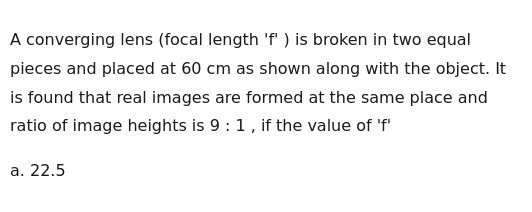Question
Question: A converging lens (focal length 'f' ) is broken in two equal pieces and placed at 60 cm as shown alo...
A converging lens (focal length 'f' ) is broken in two equal pieces and placed at 60 cm as shown along with the object. It is found that real images are formed at the same place and ratio of image heights is 9 : 1 , if the value of 'f'

22.5
22.5
Solution
Let the object be placed at a distance u from the first lens piece. Let the first lens piece be at x=0 and the second lens piece be at x=60 cm. The object is at x=−u. The focal length of each piece is f.
For the first lens piece at x=0: Object distance u1=−u. Let the image distance be v1. Using the lens formula v11−u11=f1: v11−−u1=f1⟹v11+u1=f1 v1=u−ffu. For a real image, v1>0, which requires u>f (since f>0,u>0). The image is formed at x=v1.
For the second lens piece at x=60: The object is at x=−u. The distance of the object from the second lens piece is 60−(−u)=60+u. Object distance u2=−(60+u) (since the object is to the left of the lens). Let the image distance be v2. Using the lens formula v21−u21=f1: v21−−(60+u)1=f1⟹v21+60+u1=f1 v2=60+u−ff(60+u). For a real image, v2>0, which requires 60+u>f. The image formed by the second piece is at x=60+v2.
The real images are formed at the same place, so the x-coordinates of the images are equal: v1=60+v2. Substitute the expressions for v1 and v2: u−ffu=60+60+u−ff(60+u) u−ffu−60+u−ff(60+u)=60 (u−f)(60+u−f)fu(60+u−f)−f(60+u)(u−f)=60 The numerator is f[u(60+u−f)−(60+u)(u−f)]=f[(60u+u2−uf)−(60u−60f+u2−uf)]=f[60u+u2−uf−60u+60f−u2+uf]=f(60f)=60f2. So, (u−f)(60+u−f)60f2=60 f2=(u−f)(60+u−f) f2=60u+u2−uf−60f−uf+f2 0=u2+(60−2f)u−60f.
The magnification for the first piece is m1=u1v1=−uv1. The magnification for the second piece is m2=u2v2=−(60+u)v2. The height of the image formed by the first piece is h1=∣m1∣ho=∣−uv1∣ho=uv1ho (since v1>0,u>0). The height of the image formed by the second piece is h2=∣m2∣ho=∣−(60+u)v2∣ho=60+uv2ho (since v2>0,60+u>0).
The ratio of image heights is given as 9:1. So h2h1=9 or h1h2=9. Case 1: h2h1=9 v2/(60+u)v1/u=9⟹v2uv1(60+u)=9. Substitute v1=u−ffu and v2=60+u−ff(60+u): 60+u−ff(60+u)uu−ffu(60+u)=9 f(60+u)u(u−f)fu(60+u)(60+u−f)=9 u−f60+u−f=9 60+u−f=9(u−f) 60+u−f=9u−9f 60+8f=8u u−f=860=7.5. So u=f+7.5.
Substitute u=f+7.5 into the quadratic equation u2+(60−2f)u−60f=0: (f+7.5)2+(60−2f)(f+7.5)−60f=0 (f2+15f+56.25)+(60f+450−2f2−15f)−60f=0 f2+15f+56.25+60f+450−2f2−15f−60f=0 (f2−2f2)+(15f+60f−15f−60f)+(56.25+450)=0 −f2+0f+506.25=0 f2=506.25 f=506.25=22.5 cm.
We should check if this value of f is consistent with the real image conditions u>f and 60+u>f. If f=22.5, then u=f+7.5=22.5+7.5=30. u=30>f=22.5, so the first condition is satisfied. 60+u=60+30=90. 90>f=22.5, so the second condition is satisfied. Both images are real.
Case 2: h1h2=9 v1/uv2/(60+u)=9⟹v1(60+u)v2u=9. Using the same substitution as before: u−ffu(60+u)60+u−ff(60+u)u=9 fu(60+u)(60+u−f)f(60+u)u(u−f)=9 60+u−fu−f=9 u−f=9(60+u−f) u−f=540+9u−9f 8f−8u=540 f−u=8540=67.5. So u=f−67.5. Since u is the magnitude of the object distance, u>0. This implies f>67.5. Substitute u=f−67.5 into the quadratic equation u2+(60−2f)u−60f=0: (f−67.5)2+(60−2f)(f−67.5)−60f=0 (f2−135f+67.52)+(60f−60×67.5−2f2+135f)−60f=0 (f2−135f+4556.25)+(60f−4050−2f2+135f)−60f=0 (f2−2f2)+(−135f+60f+135f−60f)+(4556.25−4050)=0 −f2+0f+506.25=0 f2=506.25 f=506.25=22.5 cm.
In this case, f=22.5 cm. Then u=f−67.5=22.5−67.5=−45. The magnitude of the object distance u must be positive. The initial setup assumed the object is to the left of the first lens piece, so its coordinate is −u where u>0. If u=−45, it means the object is at x=45. Let's reconsider the setup with the object at x=45. The first lens is at x=0, the second lens is at x=60. Object at x=45. For the first lens at x=0: Object distance u1=45−0=45. This is to the right, so u1=+45. v11−451=22.51=45/21=452. v11=452+451=453=151. So v1=15. Image is at x=0+15=15. This is a real image. Magnification m1=u1v1=4515=31. Height h1=31ho.
For the second lens at x=60: Object at x=45. Distance is 60−45=15. This is to the left of the second lens, so u2=−15. v21−−151=22.51=452. v21+151=452. v21=452−151=452−3=−451. So v2=−45. Image is at x=60+(−45)=15. This is a virtual image. The problem states that real images are formed at the same place. So this case (u=f−67.5) is not valid because it leads to a virtual image from the second lens.
The only valid case is u=f+7.5, which gives f=22.5 cm and u=30 cm. Let's check the image heights ratio for this case. u=30,f=22.5. v1=u−ffu=30−22.522.5×30=7.522.5×30=3×30=90. Image at x=90. v2=60+u−ff(60+u)=60+30−22.522.5×(60+30)=90−22.522.5×90=67.522.5×90=67.522.5×90=31×90=30. Image at x=60+30=90. The images are indeed formed at the same place (x=90). Both are real (v1>0,v2>0).
Magnification m1=u1v1=−3090=−3. h1=∣m1∣ho=3ho. Magnification m2=u2v2=−(60+30)30=−9030=−31. h2=∣m2∣ho=31ho. The ratio of image heights is h2h1=(1/3)ho3ho=9. This matches the given ratio 9:1.
Therefore, the value of f is 22.5 cm.
The final answer is 22.5.
